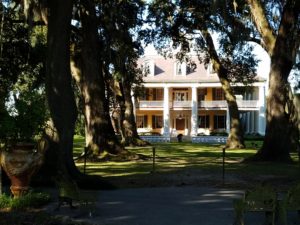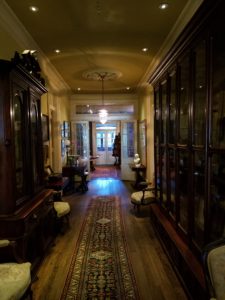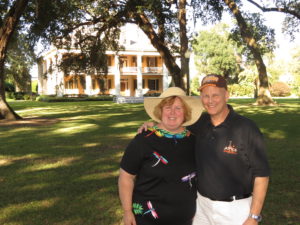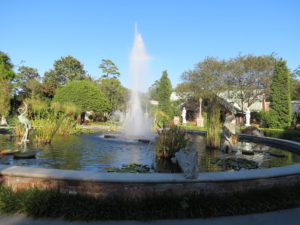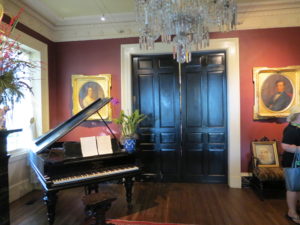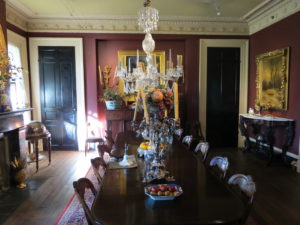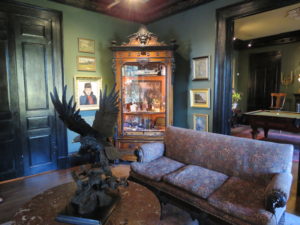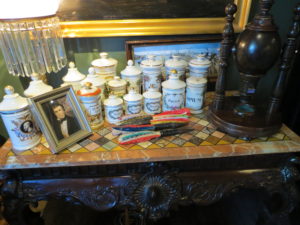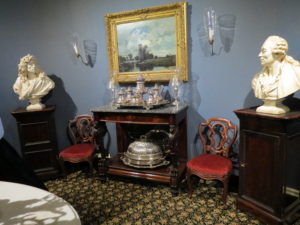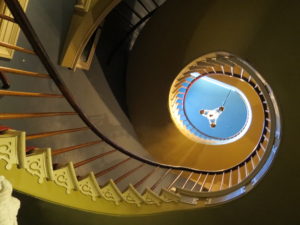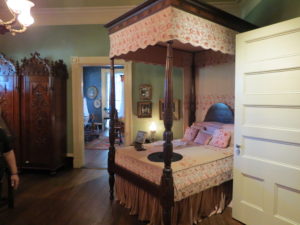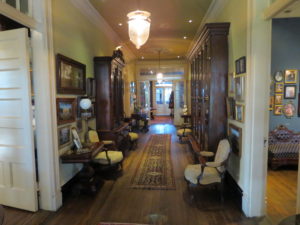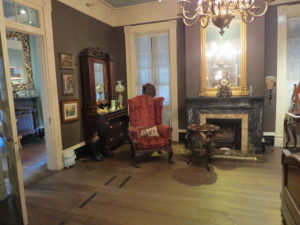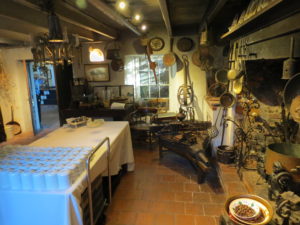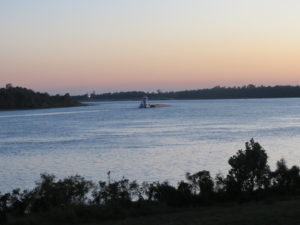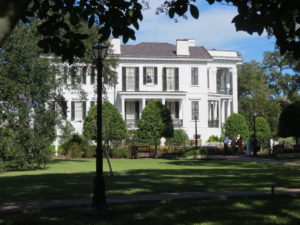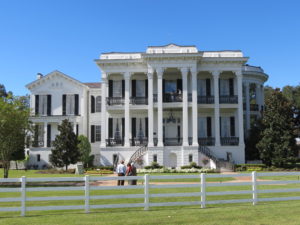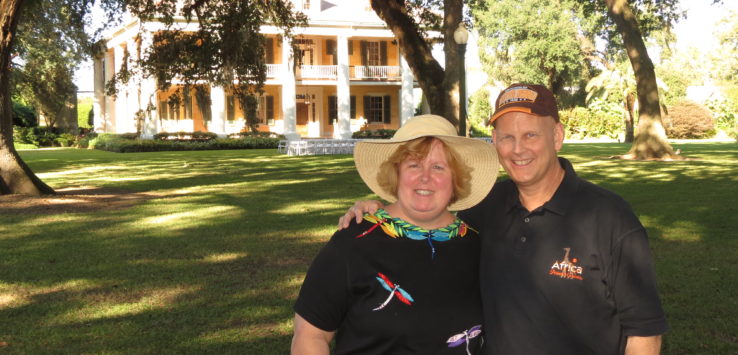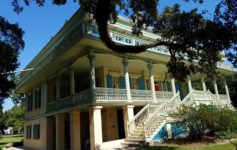Our next Plantation stop was Houmas House Plantation. We drove by the plantation front entrance, this road seemed less busy and more secluded from the street noise than our previous destination. We parked in a nicely paved parking area and saw many well maintained buildings and gardens. Our initial impression was it was better maintained but perhaps more commercialized. We paid our admission which was slightly higher $24 higher, but there were more people wandering around. The attendant in the gift shop explained they had some weddings later on so we were encouraged to walk the gardens and wait by the bell for our tour inside the home.
The gardens were more colorful and green plus several enormous trees (500-600 years old), this was in stark contrast to the previous plantation we visited. We walked around the gardens and visited with others who shared stories or tidbits.
A grand house deserves several names:
It was time for our tour at 4:30pm. We were greeted by Elizabeth our guide who wore a replica of a dress from the Antebellum area. As we approached the side of the house she explained that the first land owners were the Houmas Indians. This quickly answered our first question, how the name was derived. It also is known “The Crown Jewel of Louisiana’s River Road” and because of its abundant sugar crops it was called the ‘Sugar Palace.’
Our tour
Our guide was informative and shared interesting facts about the house. She showed us a census map that was hidden before the Civil War that showed the number of plantations that lined the Mississippi. If we heard correctly, over 1000 plantation in Louisiana this was 1/3 of the nations’ wealth in 1847. The home had many pieces of furniture from the time period, but not as many were from the original owner as we saw at the previous plantation. We can only assume because of the change in ownership.
General Wade Hampton began construction of the home which was the rear structure; however, his daughter Caroline along with her husband started building the grand home in 1825. This is the one we saw today. During this time the land holdings was over 300,000 acres. It later was sold to John Burnside who had sugar crops on less than 100,000 acres; he ultimately became one of the largest sugar cane producers in the nation. Our guide shared there were 800 slaves and 1200 Irishmen. The Irishmen were paid 10 cents each day. According to the website the plantation was fine after the great flood of 1927 but after the Great Depression the Houmas House Plantation withered away.” It is now being restored by New Orleans’ investor and entrepreneur, Kevin Kelly.
We did walk around the grounds after our tour and enjoyed an appetizer and drink in the Turtle Bar. The food, beverage and service were wonderful. In our opinion, the Asian garden is out of place with an Antebellum plantation home, but that was our only criticism. It is certainly a lovely place to stroll around and agree with reviews that it is a perfect destination for a wedding.
Visitors other than tourists come here too:
Two little fun things to share about the Houmas House, it has been the used in several movies or TV shows. As a matter of fact, Betty Davis stayed in the home while filming Hush, Hush, Sweet Charlotte. The website has a list of others you may recall http://www.houmashouse.com/movies.htm
We did not encounter any ghost visitors during our tour, but Vacationsmadeeasy.com website listed this as a haunted place. They shared these tales “ancient oak trees that are said to be inhabited by the spirits of 16 workers who lost their lives during a construction project on the Houmas House Plantation property. A young girl in a blue dress has also been seen standing on the staircase, but she rapidly disappears before anyone can talk to her.”
Plantation tours:
We learned that each Plantation and tour has a different twist but just like people, we gain different knowledge from our interaction. If we were to choose our favorite plantation we toured, it would be the Houmas Plantation because of the beautiful gardens and home exterior. Some may criticize that these plantations, a part of southern history, do not go into detail on slavery. Our research did show that many of the slave homes were torn down; however, there are some plantations that do have some on the property and provide details about this part of history. Another criticism may be that the current foundations or investors are commercializing history by adding inns, restaurants or gift shops. This is true. However, this additional revenue is no doubt part of the plan to make sure these expensive to maintain historic homes (and their history) remain around for future generations to explore.
Interested in visiting other plantations?
Nottoway is one of the largest plantations. We had brunch plans with friends, but heard from several this was worth seeing even if was brief. We could not agree more!
According to the plantations’ website: Finished “in 1859, Nottoway’s 53,000 square foot palatial white mansion awes visitors with its 64 rooms and countless extravagant features like 22 massive exterior columns, 12 hand-carved Italian marble fireplaces, exquisitely detailed plaster frieze moldings, soaring 15½-foot ceilings, enormous 11-foot doors and a lavish pure white oval ballroom, as well as unheard of innovative features, like modern bathrooms with running water and a gas plant providing gas lighting throughout the home.” One unique aspect to this plantation, overnight accommodations, “beautifully renovated historic Mansion rooms and the deluxe hotel rooms of the Cottages and Carriage House.” We would suggest experiencing it with staying overnight and then touring it. This is on our list when we return to this part of Louisiana!
Years ago we visited Oak Alley in Vacherie, Louisiana; this plantation is often photographed because of the oak trees lining the entrance to the plantation. It is considered well preserved and if you visit you will see that first hand. If you are curious about the history read it on the website http://www.oakalleyplantation.com/learn-explore/history This stately home has been in several movies http://www.oakalleyplantation.com/learn-explore/filmed-here and it has its share of ghost tales http://www.oakalleyplantation.com/learn-explore/ghost-tales
We hope you found this helpful and will enjoy exploring the Plantations of Louisiana when you are in the Baton Rouge or New Orleans area!
Follow us on Facebook or Twitter ! We encourage you to visit our sponsors (ads) on each page.
Credit:
